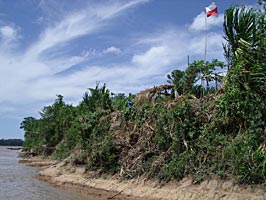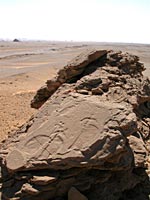Poznań excavations in the World 2001 - 2005
Exhibition will be displayed since
April 6th 2006 until August 31th, 2006.
"The
treasure dug up is not gold, but history... . Everyday there is
a new light on the past." ( W.M. Flinders Petrie )
Prehistorians from Poznań went out into the world in the 1960s.
In 1965 Lech Krzyżaniak of the Archaeological Museum in Poznań
joined the excavation teams of the Polish Centre of Mediterranean
Archaeology of Warsaw University in Cairo working successively
at Tell Atrib, Aleksandria and Luxor in Egipt and at Old Dongola
in Sudan, and in 1972, the first fully fledged independent Poznań
excavations on the Nile were opened on the site of Kadero in Sudan.
Participation of diggers from Poznań in a German expedition at
Minshat Abu Omar, Egipt (1978-1990) began a New era of Poznan
archaeological institutions marked by specialization in the field
of predynastic and early dynastic Egipt.
A concurrent venue for activity by Poznań archaeologist was the
international Combined Prehistoric Expedition which has been in
operation since 1961. Michał Kobusiewicz of the Polish Academy
of Sciences in Poznań has been taking part in the work of this
team since 1967. Until now a few dozen adepts of archaeology from
Poznań have been involved in the research of the Nile Delta.
Another field of interest of the Poznan Archaeology is a classical
site of Novae in Bulgaria the history of which reaches back to
the 1970. The year 2000 saw a considerable intensification of
archaeological investigations abroad led by Poznan institutions.
The new countries that welcome expeditions from Poznan include
Turkey, Ukraine and Bolivia.
Novae (Bulgaria). Investigations of a Roman Military
Camp and an Early Byzantine town. The research has been carried
out since 1970 by an international expedition of the AMU and the
Bulgarian Academy of Science. The project leaders are Andrzej
Biernacki and Evgenia Genczewa.
Kadero (The Sudan). Kadero, one of the most important
Neolithic sites in North Africa, was researched since 1972 till
2001. The work was directed by Lech Krzyżaniak, and many archaeologists
from Poznań started their African experience at this place.
Dakhla Oasis (Egypt) An international expedition
directed by Anthony Mills since 1976 was joined in 1985 by Poznań
team led by Lech Krzyżaniak. It continues work as a separate research
project of recording the rock art.
Tell el Farcha (Egypt) A settlement complex in
the eastern Nile Delta, flourishing from the Predynastic Period
to the early Old Kingdom. In 1987-1990 it was excavated by an
Italian expedition. In 1998 exploration was resumed by the Polish
Archaeological Expedition to the Eastern Nile Delta, co-directed
by Marek Chłodnicki (Poznań Archaeological Museum) and Krzysztof
Ciałowicz (Jagiellonian University in Cracow)
Letti (The Sudan) Research at the Neolithic sites
of El-Ghaddar, Hambukol and Megauda South conducted by Marek Chłodnicki
and Jacek Kabaciński in cooperation with the Royal Ontario Museum
in Toronto.
Central Asia Research by Andrzej Rozwadowski
from the Institute of the East of the AMU concerning the cultural
traditions in the rock art of the Central Asia.
Nagaa (The Sudan) Excavation at one of the biggest
archaeological sites in Africa are conducted by the Ägyptisches
Museum und Papyrussammlung since 1995. The mission is directed
by Dietrich Wildung, and Lech Krzyżaniak took part in the work,
as well as many archaeologists from Poznań representing Poznań
Archaeological Museum and Institute of Archaeology and Ethnology,
Polish Academy of Sciences.
Gebel Ramla (Egypt) Predynastic cemetery, discovered
in 2001 in the Western Desert by the Combined Prehistoric Expedition.
The research was made by Michał Kobusiewicz and Jacek Kabaciński
from the Institute of Archaeology and Ethnology, Polish Academy
of Sciences.
Çatalhöyük (Turkey) The site was discovered and
excavated in the 60ties by James Mellaart . In 1993 archaeological
research was started again by Ian Hodder within an international,
multidisciplinary project. Polish archaeologists joined the project
in 2001 under direction of Lech Czerniak ( Polish Academy of Sciences,
Poznań branch) and Arkadiusz Marciniak (Adam Mickiewicz University)
Taurician Chersonese (Ukraine) is an ancient,
Classical town. Excavations are carried out by an international
expedition of AMU and the National Reservetion "Chersones Tavriceski
- Sevastopol".The project leaders are Andrzej B. Biernacki and
Elena Klenina.
Meroe (The Sudan) Excavations in the southern
part of palace M750 at meroe started in 2004. The project is directed
by Krzysztof Grzymski from the Royal Ontario Museum in Toronto.
Dobiesława Bagińska participates in the work on behalf of the
Poznań Archaeological Museum
Beni (Bolivia) In 2004 Poznań-based "Czysty Świat"
("Clean World") Society started research at the Uaua-uno site in
the Beni river valley. The work is conducted in cooperation with
the Institute of Archaeology, Mikołaj Kopernik University in Toruń,
Dirección Nacional de Arqueología in La Paz, and 'Mundo Puro'
Foundation in La Paz.
Deir el-Bahari (Egypt) The temple of queen Hatshepsut
at Deir el-Bahari has been under research since the middle 19th
century. Polish archaeologists started their work in the temple
in 1961. Since 1999 the mission is directed by Zbigniew E. Szafrański
from the Warsaw University. Poznań archaeologist Andrzej Ćwiek
takes part in the work, acting as the deputy director of the mission
in the season 2005/2006.
Serengeti (Tanzania) Excavations are conducted
within a project of University of Dar es Salam and Berkeley University
under the direction of A. Mabulla and J. Bower. Poland is represented
by Michał Kobusiewicz.
 |
 |
 |
 |
|

